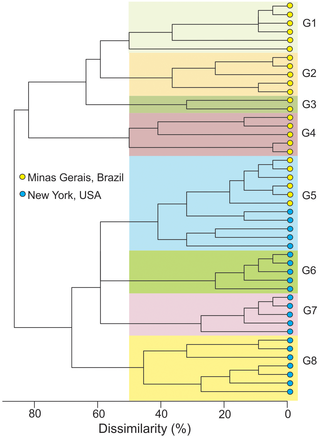 A paper by a former postdoc at the Mizubuti’s Lab (Population Biology of Plant Pathogens), Dr. Miller Lehner, has been published in PLoS ONE. The work was conducted in collaboration with the Pethybridge’s Lab (Cornell University) where the researcher worked as postdoctoral associate. Dr Lehner is currently a researcher with Monsanto in Goiás State Brazil, working on soybean diseases.
A paper by a former postdoc at the Mizubuti’s Lab (Population Biology of Plant Pathogens), Dr. Miller Lehner, has been published in PLoS ONE. The work was conducted in collaboration with the Pethybridge’s Lab (Cornell University) where the researcher worked as postdoctoral associate. Dr Lehner is currently a researcher with Monsanto in Goiás State Brazil, working on soybean diseases.
Click here to read the full text
Abstract – Sclerotinia sclerotiorum populations from tropical agricultural zones have been suggested to be more variable compared to those from temperate zones. However, no data were available comparing populations from both zones using the same set of markers. In this study, we compared S. sclerotiorum populations from the United States of America (USA, temperate) and southeast Brazil (tropical) using the frequency of mycelial compatibility groups (MCGs) and 13 microsatellite (SSR) markers. Populations were sourced from diseased plants within leguminous crops in New York, USA (NY; n = 78 isolates), and Minas Gerais State, Brazil (MG; n = 109). Twenty MCGs were identified in NY and 14 were previously reported in MG. The effective number of genotypes based on Hill’s number of order 0, which corresponded to the number of multilocus genotypes (MLGs) were 22 (95% CI = 15.6–28.4) and 24 (95% CI = 18.9–29.1) in NY and MG, respectively. Clonal fractions of MLGs were 71.8% (NY) and 78.0% (MG). The effective number of genotypes based on Hill’s number of orders 1 and 2 in NY were 8.9 (95% CI = 5.2–12.6) and 4.4 (95% CI = 2.6–6.1), respectively. For MG these indices were 11.4 (95% CI = 8.7–14.1) and 7.1 (95% CI = 5.1–9.0), respectively. There were no significant differences of allelic richness, private allelic richness, gene diversity, effective number of alleles and genotype evenness between the NY and MG populations. The populations were differentiated, with 29% of total variance attributed to differences between them and G”ST and Jost’s D indices higher than 0.50. Cluster analysis revealed dissimilarity higher than 80% among most MLGs from both populations. Different alleles segregated in the populations but both had similar levels of genotypic variability.
